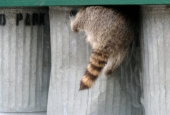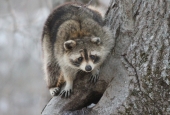Raccoons are easily recognized by their black-masked face and their fluffy tail with a ringed coloration pattern. They have husky bodies and can weigh between 15 and 40 pounds. Their fur is full and shaggy with a multi-gray coloration. The fluffy tail is tan and gray with black rings.
Raccoons are omnivorous, eating both plants and animals. They will grab fish, crayfish, and frogs out of a pond, feed on bird eggs in a nest, kill and eat mice, and eat plants from a garden. There are typically two seasonal feeding cycles. In the spring they prefer fish, crayfish, and small mammals. From summer through winter they will feed on acorns, seeds, fruits, vegetables, and insects. In an urban/suburban environment they will eat pet food.
A raccoon’s long-fingered hands and lightning speed makes them a formidable predator around ponds.
Raccoons mate from January through April and usually have one liter per year. Gestation lasts 63 days and the young kits start emerging during the summer months. A litter of kits will average between two to seven young and are fiercely protected by the mother raccoon.
Raccoons can carry an internal parasite called raccoon roundworm (
Baylisascaris procyonis). This parasite may be spread to humans by the accidental ingestion or inhalation of roundworm eggs found in raccoon feces. Raccoons often establish a specific location to urinate and defecate, called a latrine. These latrine area
s may be heavily infested with raccoon roundworms. When raccoons start a latrine in an attic, pets and humans can become infected with roundworms. Latrines may be found near woodpiles, attics, crawlspaces, fireplaces, garages, and building ledges.
Two variants of the rabies virus (bat and skunk) are found in California but all mammals are susceptible to rabies infection. The incubation period is highly variable, and typically lasts 3-8 weeks. Rabies infection is nearly always fatal. Infected animals contain large quantities of virus in their saliva, and transmission usually occurs through their bite.
Raccoons can cause extensive damage to a house. Females will rip holes in a roof or the screens off a crawl space in search of a nesting site. She may rip insulation off heating ducts and walls to build her nest and will form a latrine somewhere in the attic space. The urine will eventually stain the ceiling and cause a serious odor problem and ectoparasites (fleas and mites) can infest the attic or crawl space. Female raccoons may even enter the house in the search of a suitable nesting site.
If a resident is experiencing problems with raccoons it is strongly recommended that they call the district and set up an appointment with one of our Vector Control Biologists. The Vector Control Biologist will conduct an investigation and determine which prevention and exclusion methods would be most effective for removing the raccoons from the property.






